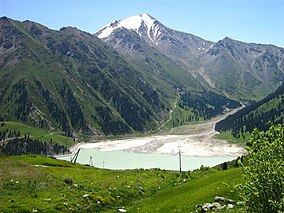
Back İle-Alatau Milli Parkı AZ Parc nacional d'Ile Alataui Catalan Parque nacional Ile-Alatau Spanish پارک ملی ایل-آلاتائو FA Parc national d'Ile-Alatau French Іле Алатауы ұлттық паркі KK ഇലെ-അലതാവു ദേശീയോദ്യാനം Malayalam Park Narodowy Ałatau Zailijskiego Polish Parque Nacional de Ile-Alatau Portuguese Иле-Алатауский национальный парк Russian
| Ile-Alatau State National Nature Park | |
|---|---|
 View of Big Almaty Lake | |
| Location | Trans-Ili Alatau, Tian Shan |
| Nearest city | Almaty, Kazakhstan |
| Coordinates | 43°5′0″N 77°5′0″E / 43.08333°N 77.08333°E |
| Area | 200,000 ha (490,000 acres) |
| Established | 1996 |
Ile-Alatau State National Nature Park (Kazakh: Іле Алатауы мемлекеттік ұлттық табиғи паркі, romanized: Ile Alatauy memlekettık ūlttyq tabiği parkı; Russian: Иле-Алатауский государственный национальный природный парк, romanized: Ile-Alatauskiy gosudarstvennyy natsional'nyy prirodnyy park) is a national park in Kazakhstan, established in 1996. Covering an area of approximately 200,000 hectares, the park is situated in the Trans-Ili Alatau mountains, south of Almaty, and stretches between the Turgen gorge in the east and the Chemolgan river in the west. It borders the Almaty Nature Reserve, which encompasses the area around Pik Talgar.[1][2]
The park’s diverse landscape includes woodlands, alpine meadows, glaciers, and lakes, with Big Almaty Lake being one of its prominent features. The flora of the park is equally varied, with significant tree species such as apricot, maple, and apple trees. The park is also home to an array of wildlife, with over 300 recorded species of birds and animals.[3]
Ile-Alatau National Park is known for its biodiversity, with notable species including the snow leopards, Central Asian lynx, Tian Shan brown bears, Central Asian stone martens, Siberian ibexes, bearded vultures and golden eagles. It also provides habitat for several unique bird species, including the Himalayan snowcock, ibisbill, Eurasian scops owl, and Eurasian three-toed woodpecker.[4][5][6] Furthermore, the park is home to species of deer, whose antlers are believed to possess medicinal properties.[7]
The park plays a role in the conservation of the region's natural heritage, protecting both flora and fauna in the Trans-Ili Alatau mountains. Its diverse ecosystems make it an area for both scientific research and eco-tourism, offering hiking, wildlife observation, and observing mountainous landscapes.
- ^ "Ile-Alatau National Park". almaty-kazakhstan.net. Retrieved 15 February 2014.
- ^ "State National Park "Ile-Alatau"". welcometokazakhstan.com. Archived from the original on 24 February 2014. Retrieved 15 February 2014.
- ^ "Ile-Alatau National Park". Weekenborg Solutions. Retrieved 9 July 2013.
- ^ "Species With Materials Recorded in Ile Alatau National Park". Retrieved 9 July 2013.
- ^ "Ile-Alatau national park". trekkingclub.kz. Retrieved 15 February 2014.
- ^ "Tour Kazakhstan - Hidden Zhetysu Wonderland". bioexploration.org. Archived from the original on 9 March 2010. Retrieved 15 February 2014.
- ^ Himes, Katherine (June 30, 2015). "Science and Culture Collide: Living and Working as a Science Diplomat in Central Asia". Science and Diplomacy. Archived from the original on July 15, 2020. Retrieved July 6, 2015.
Various special types of deer are protected for the specific purpose of harvesting blood from the horn. This blood is then used to create a traditional tincture, purported to cure many ailments—anemia, virility issues, and immune deficiency problems.

